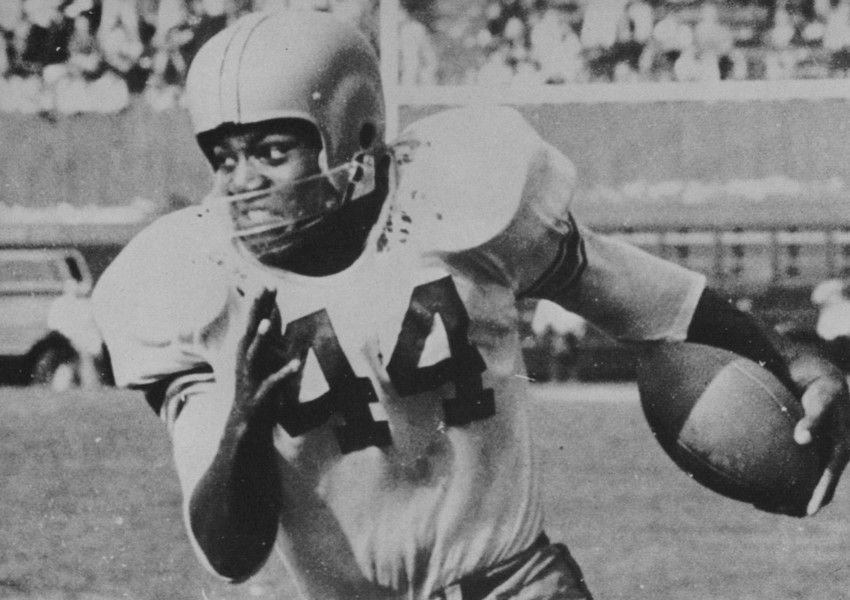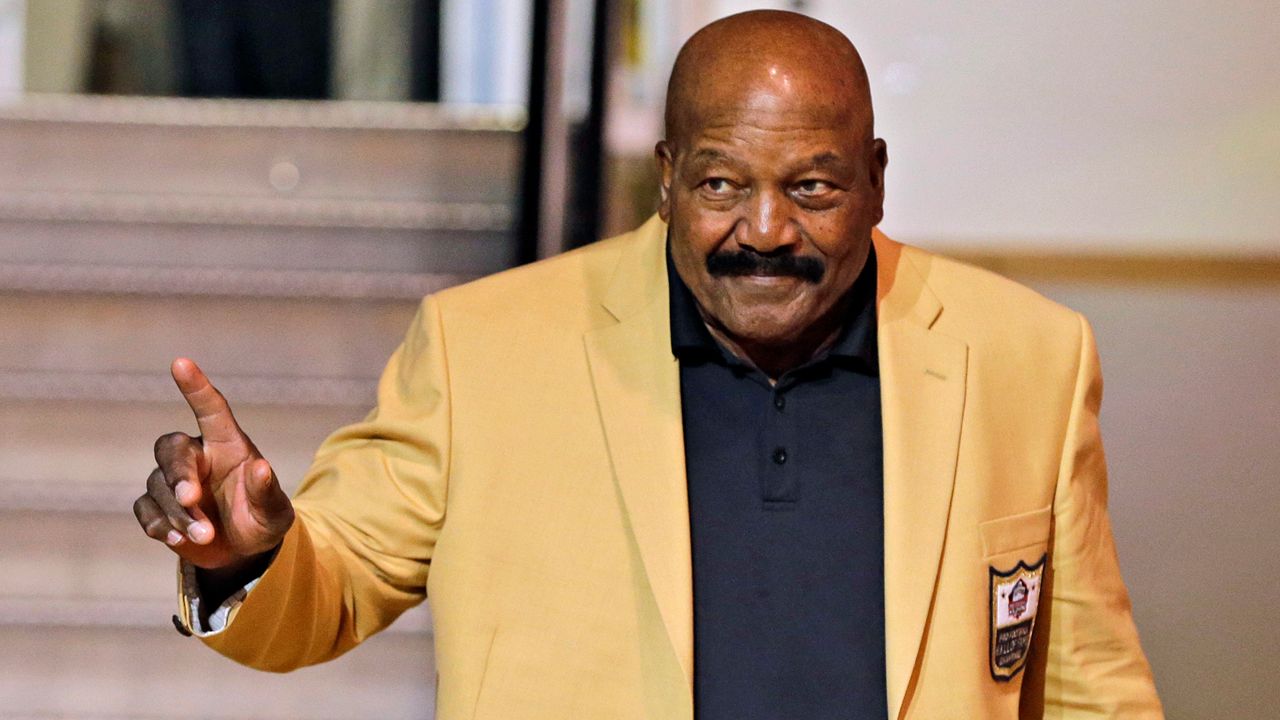Pro Football Hall of Famer and Syracuse University great Jim Brown, the unstoppable running back who retired at the peak of his brilliant career to become an actor as well as a prominent civil rights advocate during the 1960s, has died. He was 87.
A spokeswoman for Brown’s family said he passed away peacefully in his Los Angeles home on Thursday night with his wife, Monique, by his side.
One of the greatest players in football history and one of the game’s first superstars, Brown was chosen the NFL’s Most Valuable Player in 1965 and shattered the league’s record books in a short career spanning 1957-65.
Brown led the Cleveland Browns to their last NFL title in 1964 before retiring in his prime after the ’65 season to become an actor. He appeared in more than 30 films, including “Any Given Sunday” and “The Dirty Dozen.”
“Jim Brown is a true icon of not just the Cleveland Browns but the entire NFL," said Jimmy and Dee Haslam, owners of the Cleveland Browns, in a statement. "He was certainly the greatest to ever put on a Browns uniform and arguably one of the greatest players in NFL history. Jim was one of the reasons the Browns have such a tremendous fan base today. So many people grew up watching him just dominate every time he stepped onto the football field but his countless accolades on the field only tell a small part of his story."
An unstoppable runner with power, speed and endurance, Brown’s arrival sparked the game’s burgeoning popularity on television.
As Black Americans fought for equality, Brown used his platform and voice to advance their cause.
In 1967, Brown organized a meeting in Cleveland of the nation’s top Black athletes, including Bill Russell and Lew Alcindor, who later became Kareem Abdul-Jabbar, to support boxer Muhammad Ali’s fight against the war in Vietnam.
In later years, he worked to curb gang violence in LA and founded Amer-I-Can, a program to help disadvantaged inner-city youth and ex-convicts.
On the field, there was no one like Brown, who would blast through would-be tacklers, refusing to let one man take him down before sprinting away from linebackers and defensive backs. He was also famous for using a stiff arm to shed defenders in the open field or push them away like they were rag dolls.
“My arms were like my protectors and weapons,” Brown said during an interview with NFL Films.
Indeed, Brown was unlike any back before him, and some feel there has never been anyone better than Cleveland’s incomparable No. 32. At 6-foot-2, 230 pounds, he was dominant, relentless and without mercy, his highlight reels featuring runs around and right through opponents, fighting for every yard, dragging multiple defenders along or finding holes where none seemed to exist.
After Brown was tackled, he’d slowly rise and walk even more slowly back to the huddle — then dominate the defense when he got the ball again.
Off the field, Brown was a contentious character.
While he had a soft spot for those in need, and his generosity changed lives, he also was arrested a half-dozen times, mostly on charges of hitting women.
In June 1999, Brown’s wife, Monique, called 911, saying Brown had smashed her car with a shovel and threatened to kill her. During the trial, Monique Brown recanted. Jim Brown was acquitted of a charge of domestic threats but convicted of misdemeanor vandalism. The Los Angeles judge sentenced Brown to six months in jail when he refused to attend domestic violence counseling.
He also feuded with Browns coach Paul Brown and later with the team’s management, although he played his entire career with Cleveland.
When his playing days ended, Brown set off for Hollywood and eventually settled there. Brown advised Cleveland coach Blanton Collier of his retirement while the team was in training camp and he was on the set of “The Dirty Dozen” in England.
Among his films were “100 Rifles,” “Mars Attacks!” Spike Lee’s “He Got Game,” Oliver Stone’s “Any Given Sunday,” and the satire “I’m Gonna Git You Sucka,” in which he parodied the blaxploitation genre. In 2002, Brown was the subject of Lee’s HBO documentary “Jim Brown: All-American.”
In recent years, Brown’s relationship with the Browns was inconsistent. He served as an adviser to owner Randy Lerner and was hired to counsel the team’s younger players. However, in 2010, Brown parted ways with the team after having his role reduced by incoming team president Mike Holmgren. Brown felt slighted by the perceived demotion — when the club unveiled a “Ring of Honor” inside its downtown stadium, Brown didn’t attend the ceremony in protest.
Brown was an eight-time All-Pro and went to the Pro Bowl in each of his nine years in the league. When Brown walked away from the game at age 30, he held the league’s records for yards (12,312) and touchdowns (126).
And despite his bruising style, Browns never missed a game, playing in 118 straight.
“He told me, ‘Make sure when anyone tackles you he remembers how much it hurts,’” said Hall of Fame tight end John Mackey. “He lived by that philosophy and I always followed that advice.”
A two-sport star at Syracuse University — some say he is the best lacrosse player in NCAA history — Brown endured countless racist taunts while playing at the virtually all-white school at the time. Still, he was an All-American in both sports, leading the nation in scoring, and lettered in basketball.
He finished fifth in Heisman voting his senior season of 1956, though would wind up No. 1 on ESPN’s 2020 list of greatest college football players of all time.

Brown wore the started the legend of No. 44 for the Orange — later worn by Ernie Davis and Floyd Little and retired in 2005. The number was so revered at the university that the school changed its postal code to 13244 in its honor.
"Jim Brown was the greatest player to ever play the game,” Syracuse football coach Dino Babers wrote on Twitter. "I remember my dad making me watch his highlights as a kid so I could appreciate his greatness. He was the best of the best and will be forever remembered as a Syracuse legend and the best of all time."
Brown was the sixth overall pick of the 1957 draft, joining a team that routinely played for the title. He was the Offensive Rookie of the Year that season.
Running behind an offensive line featuring Hall of Fame tackles Lou Groza and Mike McCormack, Brown set a league mark with 1,527 yards and scored 17 TDs on his way to the league’s Most Outstanding Player award — a precursor to the MVP — in 1958. Over the next three seasons, he never ran for less than 1,257 yards before picking up just 996 in 1962.
"On behalf of the entire NFL family, we extend our condolences to Monique and their family," said NFL Commissioner Roger Goodell in a statement. "Jim Brown was a gifted athlete — one of the most dominant players to ever step on any athletic field — but also a cultural figure who helped promote change.



